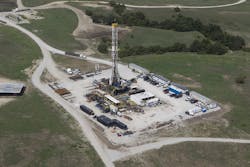Aliso Canyon disaster was nation’s largest methane release
The Aliso Canyon natural gas well blowout released more than 100,000 tons of the greenhouse gas methane, making it the largest methane leak in U.S. history, according to a new study published in the journal Science.
Natural gas started leaking on October 23, 2015 with the blowout of a well connected to the Aliso Canyon underground storage facility in California. The well was finally plugged on February 11, 2016.
Researchers from the University of California, Irvine (UCI), the National Oceanic & Atmospheric Administration, UC Davis and others said that during the peak of the disaster enough methane poured into the air every day to fill a balloon the size of the Rose Bowl.
“The methane releases were extraordinarily high, the highest we’ve seen,” said UCI atmospheric chemist Donald Blake, who has been measuring air pollutants around the world for over 30 years.
Blake also collected surface air samples near homes in the adjacent Porter Ranch residential area, revealing above-normal levels of several potentially dangerous compounds present in natural gas, including benzene, toluene and xylenes.
Stephen Conley of Scientific Aviation and UC Davis, a lead scientist on the study, said his first readings, taken in early November, were so high that he rechecked his equipment. “It became obvious that there wasn’t anything wrong with the instruments,” he said. “This was just a huge event.”
Reporting on the findings, UCI noted that the “mega-leak” has drawn attention to the broader problem of unintended emissions from natural gas production, processing, pipelines and storage infrastructure across the country.
The study confirmed that total emissions during the 112-day event were equal to one-quarter of the annual methane pollution from all other sources in the Los Angeles Basin combined.
The disaster’s impact on climate will be equivalent to the effect of annual greenhouse gas emissions from over half a million cars, the researchers said.
